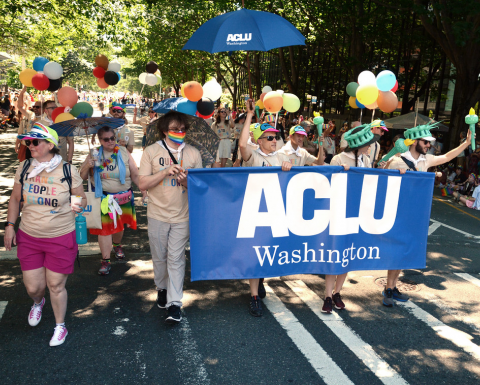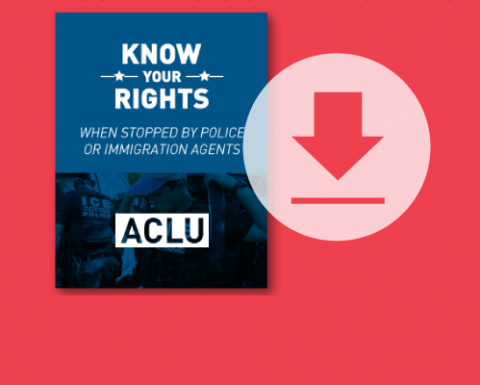What is the difference between jails and prisons?
In Washington state, individuals detained before trial or serving sentences of less than 12 months are held in local jails. Each local jail is a separate entity, administered by county or city governments. Individuals who have been convicted of a crime and sentenced to serve 12 months or more are incarcerated in state prisons. All Washington prisons are managed by the Washington State Department of Corrections (DOC), whose director is appointed by the governor.
Are there laws that protect transgender individuals from discrimination and violence in jails and prisons?
Yes. The Eighth Amendment of the US Constitution and article I, section 14 of the Washington State Constitution protect all incarcerated individuals from violence by other incarcerated people and staff. Washington's Constitution provides greater protections than the Eighth Amendment, including prohibiting cruel prison conditions.
Furthermore, the Prison Rape Elimination Act (PREA), a federal law that aims to combat sexual assault and harassment in prisons and jails, provides additional support for the protection of transgender individuals.[1] In 2012, the U.S. Department of Justice (DOJ) issued final regulations for implementing PREA across the country.[2] These DOJ regulations, known as the “PREA Standards,” contain specific protections for transgender individuals in federal, state, and local correctional facilities.[3]Are there state laws that protect transgender individuals from discrimination and violence in prisons?
Yes. Following guidance from the DOJ, the Washington State DOC adopted revised regulations to enforce the PREA Standards in Washington.[4] As a result, state DOC rules now require prisons in Washington to conduct an initial screening of all incarcerated individuals within 72 hours of arrival to assess their risk for sexual victimization and abuse, as well as a follow-up assessment between 21 and 30 days after arrival. These assessments must consider whether the individual is or is perceived to be gay/lesbian, bisexual, transgender, intersex, and/or non-binary.[5] Furthermore, facilities must consider initial screening results when making housing and program assignments to protect vulnerable individuals from abuse.[6] Facilities must also provide accommodations for transgender individuals who wish to shower separately from other incarcerated individuals.[7] Finally, the DOC is required to provide training to correctional staff that specifically addresses safety concerns for transgender and gender nonconforming individuals.[8]
Unfortunately, the Washington Law Against Discrimination (WLAD) has not been applied to protect individuals who are incarcerated. The WLAD[9] prohibits discrimination based on gender expression or identity in places of public accommodation, housing, employment, credit transactions, and insurance transactions.
|
Under the Prison Rape Elimination Act (PREA), the Washington State Department of Corrections (DOC) must investigate all reports of sexual harassment, assault, and abuse against incarcerated individuals. To report sexual misconduct against an individual in DOC custody or supervision, call the PREA Hotline at 1-800-586-9431 (0-800-586-9431 from a prison facility), email DOCPREA@doc1.wa.gov, or send a written report to: PREA Coordinator, P.O. Box 41131, Olympia, WA 98504-1131. Incarcerated individuals may also report PREA violations by submitting a kite or grievance, telling a trusted staff member, or asking a family member or friend to call the hotline. For more information about PREA reports, visit https://www.doc.wa.gov/corrections/prea/default.htm.
|
Are there state laws that protect transgender individuals from discrimination and violence in jails?
Yes. PREA applies to all jails in Washington state, regardless of whether the jail has a separate, local policy. There are a number of local jails that are developing more equitable policies for transgender individuals. For example, the King County Correctional Facility (KCCF) — the largest jail in Washington State — adopted specific guidelines to protect the rights of transgender individuals.[10] KCCF’s policies establish additional protections for transgender individuals beyond those adopted by the state. Under KCCF’s anti-harassment and discrimination policy, jail staff are prohibited from making derogatory or hurtful comments about transgender or gender nonconforming individuals, talking about or ridiculing transgender or gender nonconforming individuals to the larger incarcerated population, and asking individuals personal questions about their gender identity or expression. Further, staff must allow transgender individuals to access gender-congruent commissary items, such as bras for transgender women and shirts large enough to fit loosely over the chest. KCCF’s policies also require housing arrangements for transgender individuals to be based on the individual’s safety and security needs and to be the least restrictive option. The county also provides for separate shower accommodations upon request and PREA training for staff.[11]Thurston County has adopted similar policies, which include addressing transgender individuals by their last name and only using pronouns preferred by the individual.[12] Searches for the sole purpose of “determining” an individual’s “genital status” are prohibited in Thurston County jail, and on-duty supervisors must complete a Statement of Search Preference form. Housing assignments for transgender individuals in Thurston County jail are made on a case-by-case basis with consideration for the individual’s health and safety. Similar to those in King County, transgender individuals in Thurston County jail are allowed to purchase clothing and hygienic items consistent with their gender identity from the commissary and are provided separate shower accommodations.[13]
How does gender expression or identity influence where a person will be housed in prison?
As discussed above, Washington’s DOC has adopted regulations pursuant to federal law to protect transgender individuals from sexual assault and violence in prison.[14] The state DOC’s regulations establish specific protocols for housing incarcerated transgender, intersex, and gender nonconforming individuals. In March 2022, the DOC moved content specific to transgender individuals from their PREA policy to the Transgender, Intersex, and/or Non-Binary Housing and Supervision protocol.[15] According to these regulations, housing assignments for transgender and intersex individuals must consider the individual’s initial risk assessment, potential and identified risks of each housing option, and the individual’s own view of personal safety within each housing option.[16] Housing determinations for transgender, intersex, and gender nonconforming individuals will be reviewed every six months to assess any threats to the individual’s safety.[17] DOC policies also direct facilities to house transgender individuals with the general population, unless segregation is the only way to separate them from individuals who may harm them.[18] When transgender individuals are placed in protective custody, facilities must ensure that they retain access to the same programs afforded to the general population of the same security level.[19] Finally, jails and prisons are required to provide training to correctional staff that specifically addresses safety concerns for transgender and gender nonconforming individuals in DOC custody.[20]In practice, transgender individuals in DOC custody have issued complaints about the state's interpretation and implementation of these policies and the impact on their experiences of incarceration.
How does gender expression or identity influence where a person will be housed in a local jail?
King County requires housing assignments for transgender and gender nonconforming individuals to consider on a case-by-case basis which placement option would best ensure the individual’s health and safety. The county’s housing policy explicitly states that an individual’s own views with respect to personal safety must be given serious consideration in this process.[21] Housing assignments must be reviewed at least twice a year and must be reviewed earlier if an individual expresses fear about threats to their safety.[22] King County requires that housing decisions be the least restrictive option and presumes that individuals will be housed according to their gender identity unless there is a documented threat to their safety.[23] Decisions to place an individual in administrative segregation must be based on objective criteria without regard to gender identity. These criteria include but are not limited to the individual’s charge or conviction of a violent crime, history of victimizing others, and severe mental or physical illness.[24] Furthermore, the county’s policy specifically states that the status of being transgender cannot be considered a mental or physical illness for these purposes. Transgender and gender nonconforming individuals placed in protective custody must have access to the same programs afforded to general population individuals of the same security level.[25]Are transgender individuals protected from invasive and unnecessary physical examinations by prison officials?
Yes. Federal regulations explicitly state that facility staff may not search or physically examine a transgender or intersex individual for the sole purpose of determining the individual’s genital status.[26] To further protect transgender individuals from invasive and discriminatory searches, the regulations provide that determinations about an individual’s genital status may be made by a health care provider based on conversations with the individual or through areview of medical records.[27] Prisons and jails may only determine an individual’s genital status through physical examination when the examination is part of a broader medical examination necessary for some other purpose and is conducted in private by a health care practitioner.[28]




